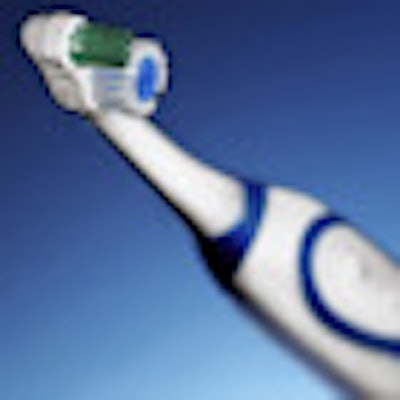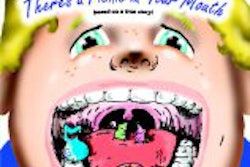
Telling patients to take better care of their teeth can seem about as effective as lecturing to an empty chair. But a study published in the October 2009 Journal of Dental Research (Vol. 88:10, pp. 933-937) suggests that behavioral techniques worked out by psychologists can make a difference.
When dentists used a "tell, show, do" method of instruction about using a power toothbrush and then asked patients to plan a change in their own behavior, the patients were more likely to improve their brushing, researchers from the University of Dundee, the University of Aberdeen, and the British National Health Service found.
— Bruce Peltier, Ph.D.
They began by analyzing research on techniques for getting people to change their behavior. "Psychological theories have rarely been applied to dental primary care interventions," they wrote.
The techniques that have been tried, such as spending 90 minutes at a time instructing patients, weren't very practical. So the researchers decided to try an approach based on two principles:
- Self-efficacy: People are most likely to change their behavior if they are confident they can do it. They are likely to gain this confidence if they try out the behavior, see someone else do it, are encouraged to keep doing it, and feel good about it.
- Intention: People are more likely to change their behavior if they have a specific plan about the circumstances for doing it.
To incorporate self-efficacy, dentists used "tell, show, do." First, they told the patients to brush twice a day for two minutes using an electric toothbrush and fluoride toothpaste, to spit rather than rinse, and to make sure their teeth felt smooth to the tongue. Second, they demonstrated brushing technique on a dummy mouth.
Third, the dentists asked the patients to brush while the dentists watched. The dentists corrected the patients' technique, asked how the patients' teeth felt, asked if the patients were confident, and praised the patients.
To incorporate intention, they said to their patients, "Before you go, can you tell me when will be the time for you to use it?" This elicited a specific commitment.
The researchers instructed 87 dentists in using this approach with patients -- then they conducted two types of trial. In the first trial, they randomly assigned 151 patients to be instructed in the behavioral technique at their next appointment, whereas another 149 patients had regular appointments with no special instruction. When the researchers surveyed the patients afterward, those who received the special instruction on average reported that they were more confident about brushing their teeth correctly and more certain of plans to do it, compared to those who just had regular appointments.
More of the specially instructed patients (86%) said they were brushing twice a day than the regular patients (72%). In addition, more (59% versus 44%) said they brushed for two minutes, and more (55% versus 36%) were rinsing but not spitting. These differences were statistically significant (p < 0.05, 0.001, and 0.001, respectively).
The specially instructed patients also had better clinical outcomes, with a slightly lower percentage of surfaces with bleeding or plaque, but these differences were not statistically significant.
The difference between the control and intervention groups in this trial may have blurred because dentists had trouble distinguishing between the two groups, the researchers theorized.
The second trial got around that problem by using cluster randomization: Rather than randomly assigning an individual dentist's patients to the control or intervention groups, the researchers randomly assigned dentists to use the new behavioral instruction with all their patients or not to use it with any.
The results of this trial were even more encouraging. Not only did the patients report better brushing technique by statistically significant margins, they also had fewer surfaces with plaque (54% versus 26%), which was statistically significant (p < 0.001). And the difference in sites bleeding (22 versus 26) approached statistical significance (p = 0.057).
"The results showed that patients who experienced the intervention indeed showed improved clinical outcomes," the researchers wrote.
"This is pretty innovative in that it uses an experimental approach to test methods of influencing patients," said Bruce Peltier, Ph.D., a professor and psychologist at the University of the Pacific School of Dentistry. Such studies are difficult and expensive because large numbers of participants are needed to get statistically meaningful results. So he praised these researchers. "They worked their ***** off," he said.
Hypnotic language
"Tell, show, do" is hardly novel, he commented. "Everything of importance in my field ends up sounding commonsensical." Still, it's helpful to have evidence that it really works.
Perhaps the biggest problem with getting patients to change their behavior is that dentists make most of their money fixing damaged teeth, he said. By comparison, getting patients to maintain their teeth doesn't pay well. "If dentistry could figure out a way to make money doing that, I think they would run in that direction," he said.
Peltier teaches another approach to improving behavior. He suggests that dentists use "hypnotic language." By carefully couching instructions in positive and optimistic ways, dentists can influence patients without having to spend a lot of time on it, he said.
"I think a lot of the vocabulary in dentistry is really counterproductive," he said. He doesn't like words such as "dismiss," "terminate," or "waiting room." "Compliance" is a prison term, he said. And "chief complaint" makes the patients sound like a whiner. "You want the healthcare practitioner teaming up with the patient," he said.
Likewise, some assumptions are implicit in ways of phrasing suggestions. "If you say 'try to floss more,' it sounds like you think they're going to fail."
In general, he suggests asking more questions that assume the patient can and will take action. So, instead, he recommends asking, "What would it take for you to floss more often?"
Observations like "you're not brushing often enough" can become the more optimistic "you're not brushing often enough yet."
Is there any evidence that this approach works? There have been some studies showing that patients are much more likely to do what they need to do when they feel a rapport with the practitioner.
But Peltier's approach has yet to undergo a clinical trial, he admitted. "It needs to be done," he said.
Copyright © 2009 DrBicuspid.com



















